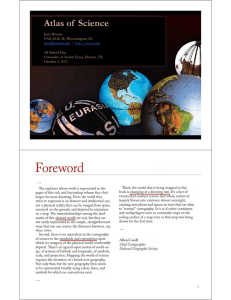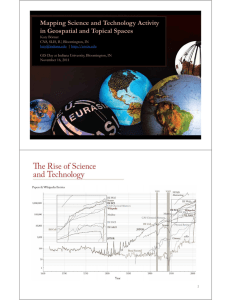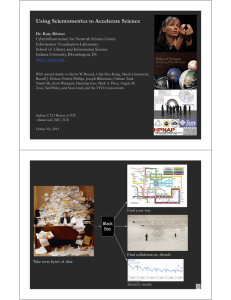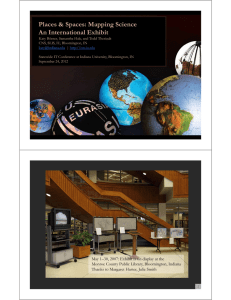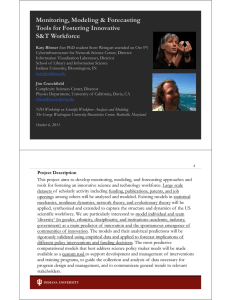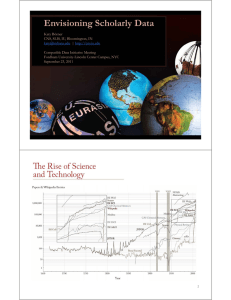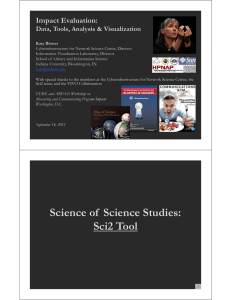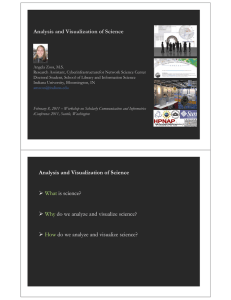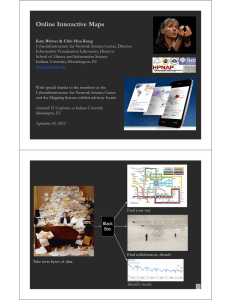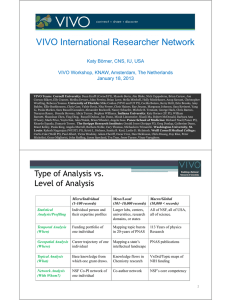Plug-and-Play Macroscopes: Custom Tools for Data Analysis Modeling and Visualization
advertisement
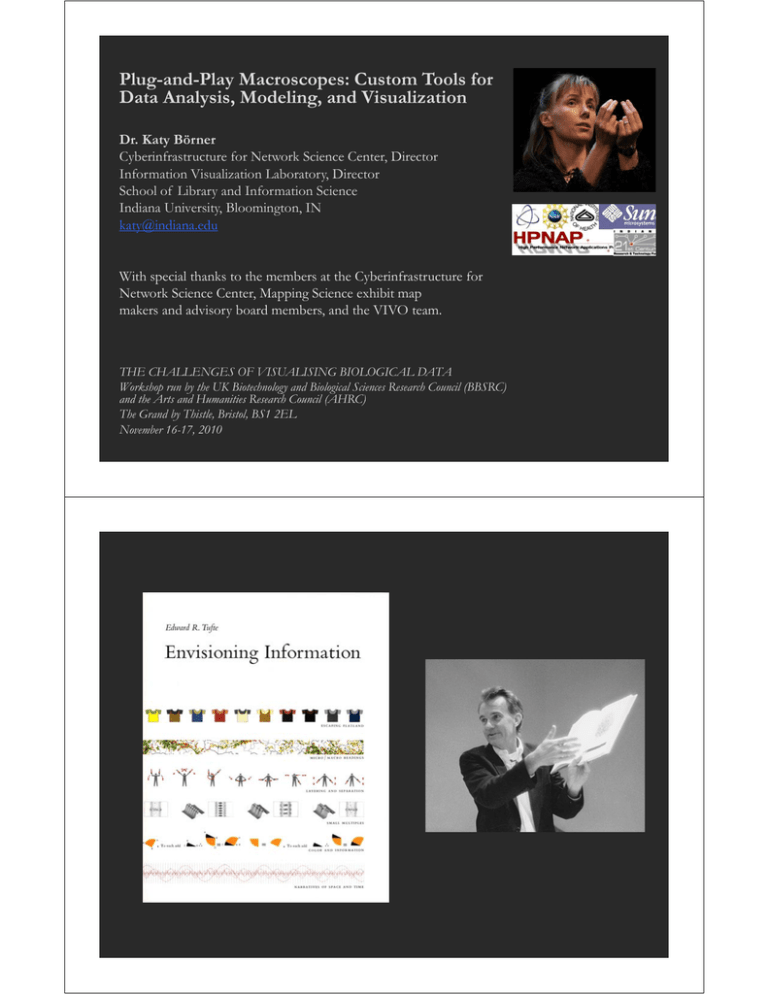
Plug-and-Play Macroscopes: Custom Tools for Data Analysis Analysis, Modeling Modeling, and Visualization Dr. Katy Börner Cyberinfrastructure for Network Science Center, Center Director Information Visualization Laboratory, Director School of Library and Information Science Indiana University, Bloomington, IN katy@indiana.edu With special thanks to the members at the Cyberinfrastructure for Network Science Center, Mapping Science exhibit map makers and advisory board members, and the VIVO team. THE CHALLENGES OF VISUALISING BIOLOGICAL DATA Workshop run by the UK Biotechnology and Biological Sciences Research Council (BBSRC) and the Arts and Humanities Research Council (AHRC) The Grand by Thistle, Bristol, BS1 2EL November 16-17, 2010 http://www.home-2009.com http://www.malarialifecycle.com The Whole Th Wh l B Brain i C Catalog: t l http://wholebraincatalog.org Drew Berry All three care deeply about 1. Data, 2. Existing expertise and insight needs, and 3. Are able to acquire the resources it takes to • • Spent months/years to deeply understand the problem/possible solutions. Render data optimally for the human perceptual-cognitive system – given our current understanding of human perception/cognition p p / g and technology. gy The result are insightful yet perceptually stunning, intellectually stimulating, i l i andd emotion i provoking ki imagery. i Today’s massive amounts of streaming data cannot be rendered d d by b h hand. d How to use computers p to “envision” biomedial science ? How to combine data mining and visualization algorithms to explore and communicate i bi biomedial di l science? Microscopes p Telescopes p Macroscopes p Plug-and-Play Macroscope Design Using OSGi/CIShell CIShell (http://cishell.org) is an open source software specification for the integration and utilization of datasets, algorithms, and tools. It I extends d the h O Open SServices i G Gateway IInitiative i i i (OSGi) (http://www.osgi.org), (h // i ) a standardized, component oriented, computing environment for networked services widely used in industry since more than 10 years. Specifically, Specifically CIShell provides “sockets” sockets into which existing and new datasets datasets, algorithms, and tools can be plugged using a wizard-driven process. Developers CIShell Wizards Users CIShell Sci2 Tool NWB Tool 10 Structure of the Remaining Talk 1.)) Type yp of Analysis y vs. Level of Analysis y Exemplified in Biomedicine 2.) Needs-Driven Workflow Design using a modular data acquisition/analysis/modeling/ visualization pipeline as well as modular visualization layers. layers Implementation p in different p plug-and-play g p y tools/CIs 1.) Type of Analysis vs. Level of Analysis Micro/Individual (1 100 records) (1-100 d) Meso/Local (101 10 000 records) (101–10,000 d) Macro/Global (10 000 < records) (10,000 d) Statistical Analysis/Profiling Individual person and their expertise profiles Larger labs, centers, universities, research domains,, or states All of NSF, all of USA, all of science. Temporal Analysis (When) Funding portfolio of one individual Mapping topic bursts in 20-years of PNAS 113 Years of Physics Research Geospatial Analysis (Where) Career trajectory of one individual Mapping a states intellectual landscape PNAS Publications Topical Analysis (What) Base knowledge from which one grant draws. Knowledge flows in Chemistry research VxOrd/Topic maps of NIH funding Network Analysis (With Whom?) NSF Co-PI network of one individual Co-author network NSF’s core competency 12 Type of Analysis vs. Level of Analysis Micro/Individual (1 100 records) (1-100 d) Meso/Local (101 10 000 records) (101–10,000 d) Macro/Global (10 000 < records) (10,000 d) Statistical Analysis/Profiling Individual person and their expertise profiles Larger labs, centers, universities, research domains,, or states All of NSF, all of USA, all of science. Temporal Analysis (When) Funding portfolio of one individual Mapping topic bursts in 20-years of PNAS 113 Years of Physics Research Geospatial Analysis (Where) Career trajectory of one individual Mapping a states intellectual landscape PNAS publciations Topical Analysis (What) Base knowledge from which one grant draws. Knowledge flows in Chemistry research VxOrd/Topic maps of NIH funding Network Analysis (With Whom?) NSF Co-PI network of one individual Co-author network NIH’s core competency 13 Mapping Indiana’s Intellect Intellectual al Space Id if Identify Geospatial/Network Analysis Pockets of innovation 2001-2006, BioMed, IN Scope Pathways from ideas to products Academic-Industryy collaborations and k knowledge g diffusion ff I Interplay l off industry i d andd academia d i 14 Mapping Topic Bursts Co-word space of the top 50 highly frequent and bursty words used in the top 10% most highly cited PNAS publications in 1982-2001. Temporal/Topical Analysis 1982-2001, US, PNAS (BioMed) Scope Topic p evolution and bursts Mane & Börner. (2004) PNAS, 101(Suppl. 1): 5287-5290. 15 Spatio-Temporal Information Production and Consumption of Major U.S. Research Institutions Börner, Katy, Penumarthy, Shashikant, Meiss, Mark and Ke, Weimao. (2006) M i the Mapping h Diffusion Diff i off Scholarly S h l l Knowledge K l d Among A Major M j U.S. U S Research R h Institutions. Scientometrics. 68(3), pp. 415-426. Research questions: 1 Does space still matter 1. in the Internet age? 2. Does one still have to studyy and work at major j research institutions in order toTemporal/Geospatial have access to Analysis high quality data and expertise and to produce high 1982-2001, US, PNAS (BioMed) Scope quality research? Citation impact p and k knowledge g diffusion ff 3 Does 3. D the h IInternet llead d to more global l b l citation i i patterns, i.e., more citation links between papers produced at geographically distant research instructions? Contributions: Answer to Qs 1 + 2 is YES. Answer to Qs 3 is NO. Novel N l approach h to analyzing l i the h dduall role l off institutions as information producers and consumers and to study and visualize the diffusion of information among them. 16 Research Collaborations by the Chinese Academy of Sciences By Weixia (Bonnie) Huang, Russell J. Duhon, Elisha F. Hardy, Katy Börner, Indiana University, USA Geospatial Analysis World, Chinese Academy of Science Collaboration and k knowledge g diffusion ff via co-author networks k This map highlights the research co-authorship collaborations of the Chinese Academy of Sciences with locations in China and countries around the world. The large geographic map shows the research collaborations of all CAS institutes. Each smaller geographic map shows the research collaborations by the CAS researchers in one province province-level level administrative division. division Collaborations between CAS researchers are not included in the data. On each map, locations are colored on a logarithmic scale by the number of collaborations from red to yellow. The darkest red is 3,395 collaborations by all of CAS with researchers in Beijing. Also, flow lines are drawn from the location of focus to all locations collaborated with with. The width of the flow line is linearly proportional to the number of collaborations with the locations it goes to, with the smallest flow lines representing one collaboration and the largest representing differing amounts on each geographic map. 17 Individual Co-PI Network Ke & Börner, (2006) Temporal/Network Analysis 2001-2006, US, InfoVis Scope Evolving project-PI networks 18 Mapping the Evolution of Co-Authorship Networks Ke, Visvanath & Börner, (2004) Won 1st price at the IEEE InfoVis Contest. 19 Temporal/Network Analysis 1986-2004, US, InfoVis Scope Evolving co-author networks and author impact 20 Studying the Emerging Global Brain: Analyzing and Visualizing the Impact of Co-Authorship Teams Börner Dall’Asta Börner, Dall Asta, Ke & Vespignani (2005) Complexity, Complexity 10(4):58 10(4):58-67. 67 Research question: • Iss science sc e ce driven d ve by prolific p o c single s g e experts e pe ts or by high-impact co-authorship teams? Contributions: • New approach to allocate citational credit. • Novel weighted graph representation. Temporal/Network Analysis 1986-2004, US, InfoVis Scope • Visualization of the growth of weighted co-author network. Impact of co-author relations • Centrality measures to identify author i impact. • Global statistical analysis of paper production and citations in correlation with co co-authorship authorship team size over time time. • Local, author-centered entropy measure. 21 113 Years of Physical Review http://scimaps.org/dev/map_detail.php?map_id=171 Bruce W. Herr II and Russell Duhon (Data Mining & Visualization), Elisha F. Hardy (Graphic Design), Shashikant Penumarthy (Data Preparation) and Katy Börner (Concept) Topical/Network Analysis 1893-2006, World, Physics Scope Topic p evolution,, k knowledge g diffusion, ff , Nobel predictions p 22 Topical Composition and Knowledge Flow Patterns in Chemistry Research for 1974 and 2004 Kevin W. Boyack, Katy Börner, & Richard Klavans (2007) Temporal/Network Analysis 1974-2004, US, NSF Chemistry Funding Scope Mapping the main structure, topic evolution, and knowledge diffusion 23 Latest ‘Base Map’ of Science Kevin W. Boyack, Katy Börner, & Richard Klavans (2007). Mapping the Structure and Evolution of Ch i Research. Chemistry R h 11th 11 h International I i l Conference C f on Scientometrics Si i andd Informetrics. I f i pp. 112-123. 112 123 Uses combined SCI/SSCI from 2002 • 1.07M papers, 24.5M references, 7,300 journals • Bibliographic coupling of p p r aggregated papers, r t d tto journals Initial ordination and clustering of journals gave 671 clusters Coupling counts were reaggregated at the journal cluster level to calculate the • (x,y) positions for each journal cluster • by association, (x,y) positions ii for f each h jjournall Math Law Policy Computer Tech Statistics Economics Education CompSci Vision Phys-Chem Chemistry Physics Psychology Brain Environment Psychiatry GeoScience MRI Biology BioMaterials BioChem Microbiology Pl t Plant Cancer Animal Disease & Treatments Virology Infectious Diseases 24 Science map applications: Identifying core competency Kevin W. Boyack, Katy Börner, & Richard Klavans (2007). Funding patterns of the US Department of Energy (DOE) Math Law Computer Tech Policy Statistics Economics CompSci Vision Education Phys-Chem Chemistry Physics Psychology Brain Environment GeoScience Psychiatry MRI Biology GI BioBi Materials BioChem Microbiology Plant Cancer Animal Virology Infectious Diseases 25 Science map applications: Identifying core competency Kevin W. Boyack, Katy Börner, & Richard Klavans (2007). Funding Patterns of the National Science Foundation (NSF) Math Law Computer Tech Policy Statistics Economics CompSci Vision Education Phys-Chem Chemistry Physics Psychology Brain Environment Psychiatry GeoScience MRI Biology GI BioBi Materials BioChem Microbiology Plant Cancer Animal Virology Infectious Diseases 26 Science map applications: Identifying core competency Kevin W. Boyack, Katy Börner, & Richard Klavans (2007). Funding Patterns of the National Institutes of Health (NIH) Math Law Computer Tech Policy Statistics Economics CompSci Vision Education Phys-Chem Chemistry Physics Psychology Brain Environment GeoScience Psychiatry MRI Biology GI BioBi Materials BioChem Microbiology Plant Cancer Animal Virology Infectious Diseases 27 Science map applications: Identifying core competency Kevin W. Boyack, Katy Börner, & Richard Klavans (2007). Funding Patterns of the National Institutes of Health (NIH) Math Law Computer Tech Policy Statistics Economics Education Psychology CompSci Phys-Chem Topic/Network Analysis 2002, World, Science/Social Science & DOE/NSF/NIH Funding Scope Map main structure of science and funding profiles Vision Chemistry Physics Brain Environment Psychiatry GeoScience MRI Biology GI BioBi Materials BioChem Microbiology Plant Cancer Animal Virology Infectious Diseases 28 Interactive Science Map of NIH Funding Herr II, Bruce W., Talley, Edmund M, Burns, Gully APC, Newman, David & La Rowe, Gavin. (2009). Topic/Network Analysis 2007, US, NIH Funding Scope Map main structure of NIH funding and institutes’ funding profiles http://scimaps.org/maps/nih/2007 29 Structure of the Remaining Talk 1.)) Type yp of Analysis y vs. Level of Analysis y Exemplified in Biomedicine 2.) Needs-Driven Workflow Design using a modular data acquisition/analysis/modeling/ visualization pipeline as well as modular visualization layers. layers Implementation p in different p plug-and-play g p y tools/CIs 2.) Needs-Driven Workflow Design using a modular data acquisition/analysis/ modeling/ visualization pipeline as well as modular visualization layers. Börner, Katy (2010) Atlas of Science. MIT Press. 31 Computational Scientometrics Cyberinfrastructures Scholarly Database: 25 million scholarly records http://sdb.slis.indiana.edu VIVO Research Networking h // i http://vivoweb.org b Information Visualization Cyberinfrastructure http://iv.slis.indiana.edu p Network Workbench Tool & Community Wiki http://nwb.slis.indiana.edu Science of Science (Sci2) Tool and CI Portal http://sci.slis.indiana.edu Epidemics Cyberinfrastructure http://epic.slis.indiana.edu/ 32 Network Workbench Tool p http://nwb.slis.indiana.edu The Network Workbench ((NWB)) tool supports researchers, educators, and practitioners interested in the study of biomedical, social and behavioral science, physics, and other networks. In February 2009, the tool provides more 169 plugins that support the preprocessing, analysis, modeling, and visualization of networks. More than 50 of these plugins can be applied or were specifically designed for S&T studies. It has been downloaded more than 65,000 times since December 2006. Herr II, Bruce W., Huang, Weixia (Bonnie), Penumarthy, Shashikant & Börner, Katy. (2007). Designing Highly Flexible and Usable Cyberinfrastructures for Convergence. In Bainbridge, William S. & Roco, Mihail C. (Eds.), Progress in Convergence - Technologies for Human Wellbeing (Vol. 1093, pp. 161-179), Annals of the New York Academy of Sciences, Boston, MA. 33 Computational Proteomics What relationships exist between protein targets of all drugs and all disease-gene products in the human protein–protein interaction network? Yildriim, Muhammed A., Kwan-II Goh, Michael E. E Cusick, Cusick Albert-László Barabási, and Marc Vidal. (2007). Drug-target g g Network. Nature Biotechnology 25 no. 10: 1119-1126. 34 Computational Epidemics Forecasting (and preventing the effects of) the next pandemic. Epidemic Modeling in Complex realities, V. Colizza, A. Barrat, M. Barthelemy, A.Vespignani, Comptes Rendus Biologie, 330, 364-374 (2007). Reaction-diffusion Reaction diffusion processes and metapopulation models in heterogeneous networks, V.Colizza, R. Pastor Pastor-Satorras, Satorras, A.Vespignani, Nature Physics 3, 276-282 (2007). Modeling the Worldwide Spread of Pandemic Influenza: Baseline Case and Containment Interventions, V. Colizza, A. Barrat, M. Barthelemy, A.-J. Valleron, A.Vespignani, PloS-Medicine PloS Medicine 4, e13, 95 95-110 110 (2007). http://sci.slis.indiana.edu/sci2 36 Sci2 Tool – “Open Code for S&T Assessment” OSGi/CIShell powered tool with NWB plugins and manyy new scientometrics and visualizations plugins. p g Sci Maps GUESS Network Vis Horizontal Time Graphs Börner, Katy, Huang, Weixia (Bonnie), Linnemeier, Micah, Duhon, Russell Jackson, Phillips, Patrick, Ma, Nianli, Zoss, Angela, Guo, Hanning & Price, Mark. (2009). Rete-Netzwerk-Red: Analyzing and Visualizing Scholarly Networks Using the Scholarly Database and the Network Workbench Tool. Proceedings of ISSI 2009: 12th International Conference on Scientometrics and Informetrics, Rio de Janeiro, Brazil, July 14-17 . Vol. 2, pp. 619-630. Sci2 Tool Geo Maps Circular Hierarchy Sci2 Tool: Algorithms See https://nwb.slis.indiana.edu/community Preprocessing Modeling Extract Top N% Records Extract Top N Records Normalize Text Slice Table by Line --------------------------------------------Extract Top Nodes Extract Nodes Above or Below Value Delete Isolates --------------------------------------------Extract top Edges Extract Edges Above or Below Value Remove Self Loops Trim by Degree MST Pathfinder Network Scaling MST-Pathfinder Fast Pathfinder Network Scaling --------------------------------------------Snowball Sampling (in nodes) Node Sampling Edge g Sampling p g --------------------------------------------Symmetrize Dichotomize Multipartite Joining --------------------------------------------G Geocoder d --------------------------------------------Extract ZIP Code Random Graph Watts-Strogatz Small World Barabási-Albert Scale-Free TARL Analysis Network Analysis Toolkit (NAT) Unweighted & Undirected Node Degree Degree Distribution --------------------------------------------K-Nearest Neighbor (Java) Watts Strogatz Clustering Coefficient Watts-Strogatz Watts Strogatz Clustering Coefficient over K --------------------------------------------Diameter Average Shortest Path Shortest Path Distribution Node Betweenness Centrality --------------------------------------------Weak Component Clustering Global Connected Components --------------------------------------------Extract K-Core C Annotate K-Coreness --------------------------------------------HITS Weighted & Undirected Clustering Coefficient Nearest Neighbor Degree g vs Degree g Strength Degree & Strength Average Weight vs End-point Degree Strength Distribution Weight Distribution Randomize Weights --------------------------------------------Blondel Community Detection --------------------------------------------HITS Unweighted & Directed Node Indegree Node Outdegree Indegree Distribution Outdegree Distribution --------------------------------------------K-Nearest Neighbor Single Node in-Out Degree Correlations --------------------------------------------Dyad Reciprocity Arc Reciprocity Adjacency Transitivity --------------------------------------------Weak Component Clustering Strong Component Clustering --------------------------------------------39 Sci2 Tool: Algorithms cont. See https://nwb.slis.indiana.edu/community -------------------------------Extract K-Core Annotate K K-Coreness Coreness -------------------------------HITS PageRank Weighted & Directed HITS Weighted PageRank Textual Burst Detection Visualization Scientometrics GnuPlot GUESS Image Viewer --------------------------------------------Radial Tree/Graph (prefuse alpha) Radial Tree/Graph with Annotation (prefuse beta) T View Tree Vi ((prefuse f beta) b ) Tree Map (prefuse beta) Force Directed with Annotation (prefuse beta) Fruchterman-Reingold with Annotation (prefuse beta) --------------------------------------------DrL (VxOrd) Specified (prefuse beta) --------------------------------------------Horizontal Line Graph Circular Hierarchy Geo Map (Circle Annotation Style) Geo Map (Colored-Region Annotation Style) Science Map (Circle Annotation) Remove ISI Duplicate Records Remove Rows with Multitudinous Fields Detect Duplicate Nodes Update Network by Merging Nodes --------------------------------------------Extract Directed Network Extract Paper Citation Network E Extract A Author h P Paper N Networkk --------------------------------------------Extract Co-Occurrence Network Extract Word Co-Occurrence Network Extract Co-Author Network Extract Reference Co Co-Occurrence Occurrence (Bibliographic Coupling) Network --------------------------------------------Extract Document Co-Citation Network NEW: Database support for ISI and NSF data. 40 Mapping Transdisciplinary Tobacco Use Research Centers Publications C Compare R01 investigator i i based b d funding f di with i h TTURC Center awards in terms of number of publications and evolving co-author networks. Z & Börner, Zoss Bö forthcoming. f th i 41 Interactive Science Map of NIH Funding Herr II, Bruce W., Talley, Edmund M, Burns, Gully APC, Newman, David & La Rowe, Gavin. (2009). http://scimaps.org/maps/nih/2007 42 MEDLINE Publication Output by The National Institutes of Health (NIH) Using Nine Years of ExPORTER Data Katy Börner Börner, Nianli Ma Ma, Joseph R. R Biberstine, Biberstine Cyberinfrastructure for Network Science Center, Center SLIS, SLIS Indiana University, University Robin M. Wagner, Rediet Berhane, Hong Jiang, Susan E. Ivey, Katrina Pearson and Carl McCabe, Reporting Branch, Division of Information Services, Office of Research Information Systems, Office of Extramural Research, Office of the Director, National Institutes of Health (NIH), Bethesda, MD. 43 Where Are the Academic Jobs? Interactive Exploration of Job Advertisements in Geospatial and Topical Space Angela Zoss, Michael Connover, Katy Börner (2010) http://cns-nd3.slis.indiana.edu/mapjobs/geo 44 Computational Scientometrics Cyberinfrastructures Scholarly Database: 25 million scholarly records http://sdb.slis.indiana.edu VIVO Research Networking h // i http://vivoweb.org b Information Visualization Cyberinfrastructure http://iv.slis.indiana.edu p Network Workbench Tool & Community Wiki http://nwb.slis.indiana.edu Science of Science (Sci2) Tool and CI Portal http://sci.slis.indiana.edu Epidemics Cyberinfrastructure http://epic.slis.indiana.edu/ 45 Scholarly Database: Web Interface http://sdb.slis.indiana.edu Supports federated search of 25 million publication, patent, grant records. Results can be downloaded as data dump and (evolving) co-author, paper-citation networks. Register for free access at http://sdb.slis.indiana.edu 46 Since March 2009: Users can download networks: - Co-author - Co-investigator - Co-inventor Co ve o - Patent citation and tables for burst analysis in NWB. VIVO: O A Semantic Se a t c Approach pp oac to Creating C eat g a National at o a Network et o of Researchers (http://vivoweb.org) • Semantic web application pp and ontology gy editor originally developed at Cornell U. • Integrates research and scholarship info from systems of record across institution(s). institution(s) • Facilitates research discovery and crossdisciplinary collaboration. Soon: • Simplify reporting tasks, e.g., generate biosketch, department report. Cornell University: Dean Krafft (Cornell PI) PI), Manolo Bevia Bevia, Jim Blake Blake, Nick Cappadona Cappadona, Brian Caruso Caruso, Jon Corson-Rikert, Corson-Rikert Elly Cramer, Cramer Medha Devare Devare, John Fereira, Brian Lowe, Stella Mitchell, Holly Mistlebauer, Anup Sawant, Christopher Westling, Rebecca Younes. University of Florida: Mike Conlon (VIVO and UF PI), Cecilia Botero, Kerry Britt, Erin Brooks, Amy Buhler, Ellie Bushhousen, Chris Case, Valrie Davis, Nita Ferree, Chris Haines, Rae Jesano, Margeaux Johnson, Sara Kreinest, Yang Li, Paula Markes, Sara Russell Gonzalez, Alexander Rockwell, Nancy Schaefer, Michele R. Tennant, George Hack, Chris Barnes, Narayan Raum, Brenda Stevens, Alicia Turner, Stephen Williams. Indiana University: Katy Borner (IU PI), William Barnett, Shanshan Chen, Ying Ding, Russell Duhon, Jon Dunn, Micah Linnemeier, Nianli Ma, Robert McDonald, Barbara Ann O'Leary, Mark Price, Yuyin Sun, Alan Walsh, Brian Wheeler, Angela Zoss. Ponce School of Medicine: Richard Noel (Ponce PI), Ricardo Espada, Damaris Torres. The Scripps Research Institute: Gerald Joyce (Scripps PI), Greg Dunlap, Catherine Dunn, Brant Kelley, Paula King, Angela Murrell, Barbara Noble, Cary Thomas, Michaeleen Trimarchi. Washington University, St. Louis: Rakesh Nagarajan (WUSTL PI), Kristi L. Holmes, Sunita B. Koul, Leslie D. McIntosh. Weill Cornell Medical College: Curtis Cole (Weill PI), Paul Albert, Victor Brodsky, Adam Cheriff, Oscar Cruz, Dan Dickinson, Chris Huang, Itay Klaz, Peter Michelini, Grace Migliorisi, John Ruffing, Jason Specland, Tru Tran, Jesse Turner, Vinay Varughese. VIVO Users and Needs • Faculty/Researchers ▫ Customize profile created via feeds; find potential collaborators, collaborators “people people like me”; discovery via high search rankings; info on activity of colleagues… • Students ▫ C Create t profiles; fil easily il fi find d mentors t + collaborators; ll b t llocate t ffacilities, iliti events, t funding opportunities… • Administrators ▫ Quickly find cross-disciplinary expertise (research area; geography); centralize public data from diverse sources; easily repurpose information for consumers; improve faculty collaboration within or across departments and institutions… • Funding, donor, legislative agencies ▫ Discover projects, grants, expertise (e.g. for review panels; targets for funding)… • General public ▫ Find expertise, learn about research in a region/institution… VIVO Web Pages http://cals-experts.mannlib.cornell.edu/ http://research.cals.cornell.edu http://gradeducation.lifesciences.cornell.edu VIVO Data Providers & Users • Eagle-i (“enabling resource discovery” U24 award) • Federal agencies – NIH (NIH RePORTER), NSF, USDA, … Search c Providers o de s – Goog Google, e, Bing, g, Yahoo, a oo, … • Sea • Professional Societies – AAAS, … • Publishers/vendors – PubMed, PubMed Elsevier Elsevier, Collexis Collexis, ISI ISI… • Semantic Web community – DERI, … • Consortia C i off schools h l – SURA, S A C CTSA… SA • Producers, consumers of semantic web-compliant data VIVO & Linked Open p Data 2010 National VIVO Conference August 12&13, NYC http://conferences.dce.ufl.edu/vivo VIVO makes high coverage, high quality data from systems of record • available online • for free, and • in machine readable format. VIVO ontology is aligned O o o ogy s a g ed with many existing Web 2.0 and scholarly ontologies to ease interoperability ease interoperability. http://www4.wiwiss.fu-berlin.de/bizer/pub/lod-datasets_2009-07-14_colored.png Download Data Generall S G Statistics i i • 36 publication(s) from 2001 to 2010 (.CSV File) • 80 co-author(s) co author(s) from 2001 to 2010 (.CSV File) Co Author Network Co-Author (GraphML File) Save as Image g (.PNG ( file)) Tables • Publications per year (.CSV File) • Co-authors (.CSV File) http://vivovis slis indiana edu/vivo1/visualization?uri=http%3A% vis.slis.indiana.edu/vivo1/visualization?uri=http%3A% 2F%2Fvivoweb.org%2Fontology%2Fcore%2FPerson72 &vis=person_level&render_mode=standalone 54 v36 publication(s) from 2001 to 2010 (.CSV File) 80 co-author(s) from 2001 to 2010 (.CSV File) Co-author network (GraphML File) Save as Image (.PNG file) P bli i Publications per year (.CSV ( CSV Fil File), ) see top file. fil Co-authors (.CSV File) 55 56 02/2010 Science is global. World view of VIVO activity. Web site visits are aggregated at the country level. 57 04/2010 Shown are the - Number of people profiles in the 7 different VIVO installation sites plus CAS and U Melbourne. - Email contacts by data and service providers as well as institutions interested to adopt VIVO. - The number of visitors on http://vivoweb.org Circles are area size coded using a logarithmic scale. 58 06/2010 VIVO 1.0 source code was publicly released on April 14, 2010 87 downloads by June 11, 2010. The more institutions adopt VIVO, the more high quality data will be available to understand, navigate, manage, utilize, and communicate progress in science and technology. 59 Computational Scientometrics References Börner, Katy, Chen, Chaomei, and Boyack, Kevin. (2003). Visualizing Knowledge Domains. In Blaise Cronin (Ed ) ARIST, (Ed.), ARIST Medford, Medford NJ: Information Today, Today Inc./American Society for Information Science and Technology, Volume 37, Chapter 5, pp. 179-255. http://ivl.slis.indiana.edu/km/pub/2003-borner-arist.pdf Shiffrin, Richard M. and Börner, Katy (Eds.) (2004). Mapping Knowledge Domains. Proceedings of the National Academy of Sciences of the United States of America, 101(Suppl_1). http://www pnas org/content/vol101/suppl 1/ http://www.pnas.org/content/vol101/suppl_1/ Börner, Katy, Sanyal, Soma and Vespignani, Alessandro (2007). Network Science. In Blaise Cronin (Ed.), ARIST, Information Today, d y, Inc./American / Societyy for Information Science and Technology, Medford, NJ, Volume 41, Chapter 12, pp. 537-607. http://ivl.slis.indiana.edu/km/pub/2007-borner-arist.pdf Börner, Katy (2010) Atlas of Science. MIT Press. http://scimaps.org/atlas 60 Mapping Science Exhibit – 10 Iterations in 10 years http://scimaps.org The Power of Maps (2005) Science Maps for Economic Decision Makers (2008) The Power of Reference Systems (2006) Science Maps for Science Policy Makers (2009) The Power of Forecasts (2007) Science Maps for Scholars (2010) Science S i M Maps as Visual Vi l IInterfaces t f to t Digital Di it l Libraries Lib i (2011) Science Maps for Kids (2012) Science Forecasts (2013) How to Lie with Science Maps (2014) Exhibit has been shown in 72 venues on four continents. Currently at - NSF, 10th Floor, 4201 Wilson Boulevard, Arlington, VA - Marston Science Library, University of Florida, Gainesville, FL - Center of Advanced European Studies and Research, Bonn, Germany - Science Train, Germany. 61 All papers, maps, cyberinfrastructures, talks, press are linked from http://cns.slis.indiana.edu Debut D b off 5th Iteration I i off Mapping M i SScience i E Exhibit hibi at MEDIA X was on M May 18 18, 2009 at W Wallenberg ll b H Hall, ll Stanford University, http://mediax.stanford.edu, http://scaleindependentthought.typepad.com/photos/scimaps 63 Illuminated Diagram Display W. Bradford Paley, Kevin W. Boyack, Richard Kalvans, and Katy Börner (2007) Mapping, Illuminating, and Interacting with Science. SIGGRAPH 2007. Questions: • Who is doingg research on what topic and where? • What is the ‘footprint’ of interdisciplinary research fields? • What impact have scientists? Contributions: • Interactive, high g resolution interface to access and make sense of data about scholarly activity. Large-scale, high resolution prints illuminated via projector or screen. Interactive touch panel. 64 Katy Börner, Network Workbench: A CI-Marketplace for Network Scientists Science Maps in “Expedition Expedition Zukunft Zukunft” science train visiting 62 cities in 7 months 12 coaches, 300 m long Opening was on April 23rd, 2009 by German Chancellor Merkel http://www.expedition-zukunft.de 66 Bollen, Johan, Herbert Van de Sompel, Aric Hagberg, Luis M.A. Bettencourt, Ryan Chute, Marko A. Rodriquez, Lyudmila Balakireva. 2008. A Clickstream Map of Science. 67 Council for Chemical Research. 2009. Chemical R&D Powers the U.S. Innovation Engine. Washington, DC. Courtesy of the Council for Chemical Research. 68
